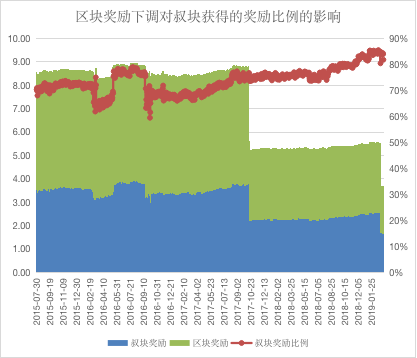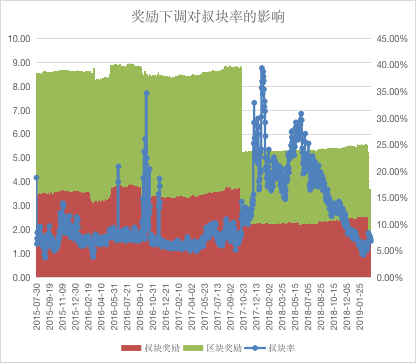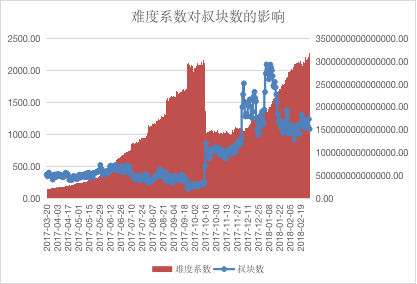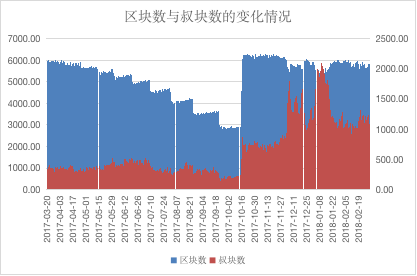Uncle of the Ethereum Reward Mechanism (middle)
As mentioned in the last article, Ethereum has experienced two block award reductions, and the block rate has increased significantly after the first reward reduction. Below we will statistically analyze the impact of the block size reduction, the mining difficulty coefficient, and the daily generation of the common block on the uncle block rate (the number of uncle blocks).
1. Block reward reduction

As shown in the above figure, the red curve indicates the fluctuation of the non-block reward ratio (that is, the ratio of the obtained unblocked bonus to the block reward). It can be found that the ratio is fluctuating above 50% , that is, the basic structure of the uncle is Can be packaged in three compartments. After the first block reward reduction, the non-block reward ratio is stable at 75% (ie, the interval is 1-2 ), indicating that the uncle can be found and packaged as early as possible. It can be seen that the downward adjustment of the block reward will have an impact on the proportion of rewards obtained by the unblock.

As shown in the above figure, the blue curve indicates the fluctuation of the unblock rate. From the case of the two reward reductions, there is no direct fluctuation effect on the unblock rate. From the first down analysis, the uncle block rate only went through a period of slight increase, and then entered the period of rapid growth, so the block reward did not have a direct impact on the block rate.
2. Mining difficulty coefficient
Because the mining difficulty coefficient and the calculation power fluctuate in the same direction, that is, the difficulty coefficient increases with the increase of the total network total power, so we only take the difficulty coefficient as the analysis object.
Note: The period in which the daily output of the block is most volatile is taken as the research period, that is , from March 2017 to March 2018 .

As shown in the above figure, the blue curve indicates the fluctuation of the daily output of the block. As the difficulty increases progressively, the number of blocks will be stepped down, and after the first block reward adjustment, the block day Production has again stabilized.

As shown in the above figure, the blue curve indicates the fluctuation of the daily output of the unblock. It can be found that the daily output of the unblock does not fluctuate significantly during the period of difficulty improvement, so the difficulty adjustment has no significant influence on the number of uncle blocks. . After experiencing the first block reward adjustment, the number of uncle blocks showed a slight increase, and there was a significant increase in the later period, which is now stable.
3. Daily generation of ordinary blocks
Note: The study period is from March 2017 to March 2018 .

As shown in the figure above, the red area indicates the daily generation of the unblock, and the blue area indicates the daily generation of the normal block. It can be found that when the number of ordinary blocks is decreasing, the amount of generation of the unblock is not affected. When the number of ordinary blocks tends to be stable, the number of uncle blocks appears to fluctuate significantly, so the number of blocks has no significant influence on the number of unblocks.
In summary, we can see that the three factors of reward reduction, mining difficulty coefficient and daily generation of ordinary blocks have no direct effect on the unblock rate /second block number. We will continue to analyze the uncle in the next article. The block rate produces an effect factor.
View the previous article: The Uncle Block of the Ethereum Reward Mechanism (on)
We will continue to update Blocking; if you have any questions or suggestions, please contact us!
Was this article helpful?
93 out of 132 found this helpful
Related articles
